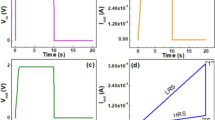Abstract
Computational amplifiers are extremely useful for generating waveforms and solving numerous equations. In this work, memristive computational amplifier circuits were developed on spice simulator platform for the generation of step, pulse, exponential, and parabolic signals. On one side, decaying characteristics have been obtained based on the controlled decrement (or increment) in the memristance when the memristor is connected in the output (or input) loop of the amplifier. On the other side, rising characteristics were generated through exchanging the polarity of the input applied signal. These characteristics were further employed to solve exponential, linear, and parabolic equations. External voltage signals and internal circuit resistances were utilized to control the signal parameters such as rise time, fall time, delay, and amplitude. In the proposed circuits, the extension or reduction in the range of the generated signals was made possible through adjusting the external bias voltages. This work paves the way for futuristic low power, improved latency, and reduced on-chip area-based computational memristive amplifiers.
Access this chapter
Tax calculation will be finalised at checkout
Purchases are for personal use only
Similar content being viewed by others
References
Chua LO (1971) Memristor—the missing circuit element. IEEE Trans Circ Theory 18(5):507–519. https://doi.org/10.1109/TCT.1971.1083337
Strukov DB, Snider GS, Stewart DR, Williams RS (2008) The missing memristor found. Nature 453(7191):80–83. https://doi.org/10.1038/nature06932
Williams RS (2014) How we found the missing memristor. In: Memristors and memristive systems. Springer, New York, pp 3–16. https://doi.org/10.1007/978-1-4614-9068-5_1
Raj PMP, Subramaniam A, Priya S, Banerjee S, Kundu S (2019) Programming of memristive artificial synaptic crossbar network using PWM techniques. J Circ Syst Comput 28(12):S0218126619502013. https://doi.org/10.1142/S0218126619502013
Chua L (2011) Resistance switching memories are memristors. Appl Phys A 102(4):765–783. https://doi.org/10.1007/s00339-011-6264-9
Raj PMP, Ranjan Kalita A, Hudait MK, Priya S, Kundu S (2018) Nonlinear DC equivalent circuits for ferroelectric memristor and its FSM application. Integr Ferroelectr 192(1):16–27. https://doi.org/10.1080/10584587.2018.1521667
Kvatinsky S, Belousov D, Liman S, Satat G, Wald N, Friedman EG, Kolodny A, Weiser UC (2014) MAGIC—memristor-aided logic. IEEE Trans Circ Syst II Express Briefs 61(11):895–899. https://doi.org/10.1109/TCSII.2014.2357292
Yakopcic C, Taha TM, Subramanyam G, Pino RE (2013) Generalized memristive device SPICE model and its application in circuit design. IEEE Trans Comput Des Integr Circ Syst 32(8):1201–1214. https://doi.org/10.1109/TCAD.2013.2252057
Alibart F, Gao L, Hoskins BD, Strukov DB (2012) High precision tuning of state for memristive devices by adaptable variation-tolerant algorithm. Nanotechnology 23(7):075201. https://doi.org/10.1088/0957-4484/23/7/075201
Shin S, Kim K, Kang S-M (2009) Memristor-based fine resolution programmable resistance and its applications. In: 2009 International conference on communications, circuits and systems. IEEE, pp 948–951. https://doi.org/10.1109/ICCCAS.2009.5250376
Zamarreño-Ramos C, Camuñas-Mesa LA, Pérez-Carrasco JA, Masquelier T, Serrano-Gotarredona T, Linares-Barranco B (2011) On spike-timing-dependent-plasticity, memristive devices, and building a self-learning visual cortex. Front Neurosci 5:26. https://doi.org/10.3389/fnins.2011.00026
Merrikh-Bayat F, Bagheri Shouraki S, Merrikh-Bayat F (2014) Memristive fuzzy edge detector. J Real-Time Image Process 9(3):479–489. https://doi.org/10.1007/s11554-012-0254-9
Pershin YV, Di Ventra M (2010) Practical approach to programmable analog circuits with memristors. IEEE Trans Circ Syst I Regul Pap 57(8):1857–1864. https://doi.org/10.1109/TCSI.2009.2038539
Mahvash M, Parker, AC (2010) A memristor SPICE model for designing memristor circuits. In: 2010 53rd IEEE international midwest symposium on circuits and systems. IEEE, pp 989–992. https://doi.org/10.1109/MWSCAS.2010.5548803
Biolek Z, Biolek D, Biolková V (2009) Spice model of memristor with nonlinear dopant drift. Radioengineering 18(2):210–214
Kvatinsky S, Ramadan M, Friedman EG, Kolodny A (2015) VTEAM: a general model for voltage-controlled memristors. IEEE Trans Circ Syst II Express Briefs 62(8):786–790. https://doi.org/10.1109/TCSII.2015.2433536
Shin S, Kim K, Kang S-M (2011) Memristor applications for programmable analog ICs. IEEE Trans Nanotechnol 10(2):266–274. https://doi.org/10.1109/TNANO.2009.2038610
Yu Q, Qin Z, Yu J, Mao Y (2009) Transmission characteristics study of memristors based Op-Amp circuits. In: 2009 International conference on communications, circuits and systems. IEEE, pp 974–977. https://doi.org/10.1109/ICCCAS.2009.5250356
Bickerstaff K, Swartzlander EE (2010) Memristor-based arithmetic. In: 2010 Conference record of the forty fourth Asilomar conference on signals, systems and computers. IEEE, pp 1173–1177. https://doi.org/10.1109/ACSSC.2010.5757715
Merrikh-Bayat F, Shouraki SB (2011) Memristor-based circuits for performing basic arithmetic operations. Procedia Comput Sci 3:128–132. https://doi.org/10.1016/J.PROCS.2010.12.022
Mouttet B (2009) Proposal for memristors in signal processing. Presented at the nano-net, pp 11–13. https://doi.org/10.1007/978-3-642-02427-6_3
Xu K-D, Zhang YH, Wang L, Yuan MQ, Fan Y, Joines WT, Liu QH (2014) Two memristor SPICE models and their applications in microwave devices. IEEE Trans Nanotechnol 13(3):607–616. https://doi.org/10.1109/TNANO.2014.2314126
Li L, Chew ZJ (2012) Printed circuit board based memristor in adaptive lowpass filter. Electron Lett 48(25):1610–1611. https://doi.org/10.1049/el.2012.2918
Driscoll T, Quinn J, Klein S, Kim HT, Kim BJ, Pershin YV, Di Ventra M, Basov DN (2010) Memristive adaptive filters. Appl Phys Lett 97(9):093502. https://doi.org/10.1063/1.3485060
Knag P, Lu W, Zhang Z (2014) A native stochastic computing architecture enabled by memristors. IEEE Trans Nanotechnol 13(2):283–293. https://doi.org/10.1109/TNANO.2014.2300342
Yilmaz Y, Mazumder P (2017) A drift-tolerant read/write scheme for multilevel memristor memory. IEEE Trans Nanotechnol 16(6):1016–1027. https://doi.org/10.1109/TNANO.2017.2741504
Zidan MA, Fahmy HAH, Hussain MM, Salama KN (2013) Memristor-based memory: the sneak paths problem and solutions. Microelectr J 44(2):176–183. https://doi.org/10.1016/j.mejo.2012.10.001
Jo K-H, Jung C-M, Min K-S, Kang S-M (2010) Self-adaptive write circuit for low-power and variation-tolerant memristors. IEEE Trans Nanotechnol 9(6):675–678. https://doi.org/10.1109/TNANO.2010.2052108
Acknowledgements
One of the authors P. M. P. Raj acknowledges UGC, Govt. of India, for Ph.D. fellowship support through NET JRF (3509/(OBC) (NET-JAN 2017)).
Author information
Authors and Affiliations
Corresponding author
Editor information
Editors and Affiliations
Rights and permissions
Copyright information
© 2020 Springer Nature Singapore Pte Ltd.
About this paper
Cite this paper
Michael Preetam Raj, P., Kalita, A.R., Kundu, S. (2020). Memristive Computational Amplifiers and Equation Solvers. In: Goel, N., Hasan, S., Kalaichelvi, V. (eds) Modelling, Simulation and Intelligent Computing. MoSICom 2020. Lecture Notes in Electrical Engineering, vol 659. Springer, Singapore. https://doi.org/10.1007/978-981-15-4775-1_9
Download citation
DOI: https://doi.org/10.1007/978-981-15-4775-1_9
Published:
Publisher Name: Springer, Singapore
Print ISBN: 978-981-15-4774-4
Online ISBN: 978-981-15-4775-1
eBook Packages: Computer ScienceComputer Science (R0)




